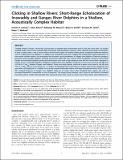Clicking in Shallow Rivers : Short-Range Echolocation of Irrawaddy and Ganges River Dolphins in a Shallow, Acoustically Complex Habitat
Abstract
Toothed whales (Cetacea, odontoceti) use biosonar to navigate their environment and to find and catch prey. All studied toothed whale species have evolved highly directional, high-amplitude ultrasonic clicks suited for long-range echolocation of prey in open water. Little is known about the biosonar signals of toothed whale species inhabiting freshwater habitats such as endangered river dolphins. To address the evolutionary pressures shaping the echolocation signal parameters of non-marine toothed whales, we investigated the biosonar source parameters of Ganges river dolphins (Platanista gangetica gangetica) and Irrawaddy dolphins (Orcaella brevirostris) within the river systems of the Sundarban mangrove forest. Both Ganges and Irrawaddy dolphins produced echolocation clicks with a high repetition rate and low source level compared to marine species. Irrawaddy dolphins, inhabiting coastal and riverine habitats, produced a mean source level of 195 dB (max 203 dB) re 1 µPapp whereas Ganges river dolphins, living exclusively upriver, produced a mean source level of 184 dB (max 191) re 1 µPapp. These source levels are 1–2 orders of magnitude lower than those of similar sized marine delphinids and may reflect an adaptation to a shallow, acoustically complex freshwater habitat with high reverberation and acoustic clutter. The centroid frequency of Ganges river dolphin clicks are an octave lower than predicted from scaling, but with an estimated beamwidth comparable to that of porpoises. The unique bony maxillary crests found in the Platanista forehead may help achieve a higher directionality than expected using clicks nearly an octave lower than similar sized odontocetes.
Citation
Jensen , F , Rocco , A , Mansur , R , Smith , B , Janik , V M & Madsen , P 2013 , ' Clicking in Shallow Rivers : Short-Range Echolocation of Irrawaddy and Ganges River Dolphins in a Shallow, Acoustically Complex Habitat ' , PLoS One , vol. 8 , no. 4 , e59284 . https://doi.org/10.1371/journal.pone.0059284
Publication
PLoS One
Status
Peer reviewed
ISSN
1932-6203Type
Journal article
Collections
Items in the St Andrews Research Repository are protected by copyright, with all rights reserved, unless otherwise indicated.

